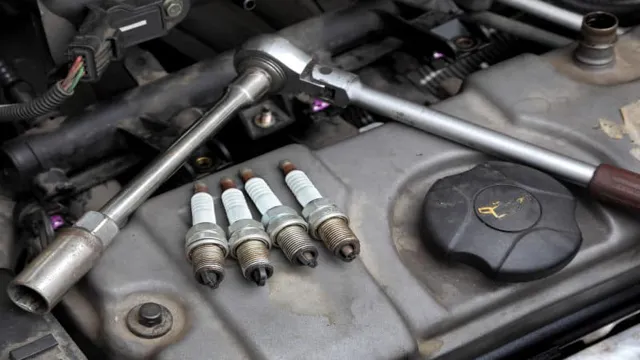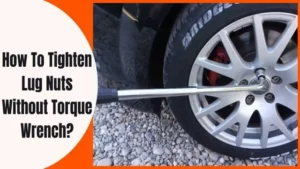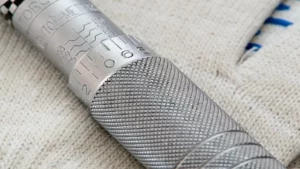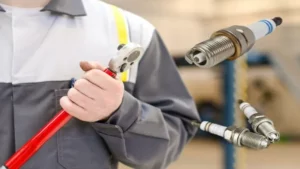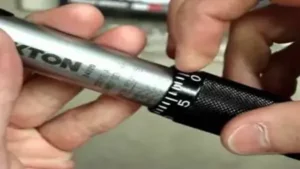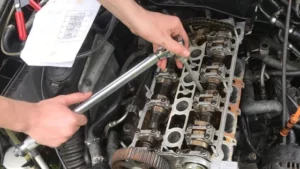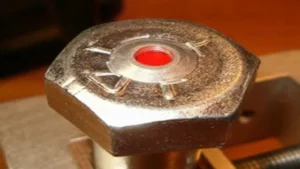Are you the DIY type or someone who likes to tinker with cars? If so, you have probably encountered one of the most common maintenance tasks, changing spark plugs. While this may seem like a straightforward job, many people wonder if they need a torque wrench for the task. The answer is, it depends.
Let’s break it down – a torque wrench is a specialty tool used to tighten bolts or nuts to a specific tightness. The goal is to achieve a precise level of tension that ensures that the fastener remains secure. On the other hand, spark plugs only need to be tight enough to stay in place and maintain a solid electrical connection.
Many people overlook the importance of how tight spark plugs are, leading to issues such as stripped threads or improper installation. Using a torque wrench can help ensure that you achieve the manufacturer’s recommended tightness, preventing these problems. However, if you’re confident in your ability to achieve a snug fit without the use of a torque wrench, it’s not entirely necessary.
It’s important to note that overtightening spark plugs can cause damage to the engine, so err on the side of caution if you choose not to use a torque wrench. In summary, if you’re not confident in your ability to tighten spark plugs correctly, a torque wrench is an excellent investment. It’s a small price to pay for peace of mind and prevention of costly repairs down the line.
Understanding Torque and Spark Plugs
If you’re wondering if you need a torque wrench for spark plugs, the answer is yes. Torque is important because it determines how tightly the spark plugs are held in place. If they’re not tight enough, there’s a risk of them coming loose and causing engine damage.
On the other hand, if they’re too tight, they can strip the threads in the cylinder head. As a result, it’s important to follow the manufacturer’s recommended torque settings, which can usually be found in the owner’s manual. A torque wrench will help you achieve the proper torque, giving you the peace of mind that your spark plugs are securely fastened without risking damage to your engine.
It’s a small investment that can save you a lot of headaches and money in the long run.
Why Torque Matters for Spark Plugs
When it comes to spark plugs, torque plays a crucial role in ensuring that they perform at their best. Torque refers to the amount of twisting force exerted on an object, and in the case of spark plugs, it’s the measure of the force that tightens them into the engine. Proper torque ensures that the spark plug is securely seated in the engine, preventing any gas leakage around the plug’s base.
If the torque is too low, the plug may not be seated properly, leading to misfires and poor engine performance. On the other hand, if the torque is too high, it may damage the engine components or strip the spark plug’s threads. Therefore, it is vital to use the manufacturer’s recommended torque specifications when tightening spark plugs.
So, if you want your engine to perform its best, don’t overlook torque’s importance when installing spark plugs.
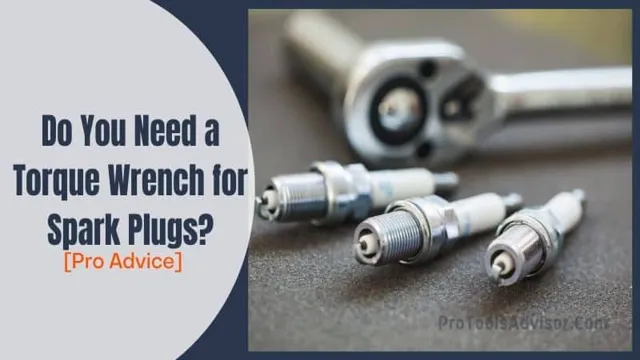
Common Problems When Torque is Not Applied Correctly
Understanding torque and its effects on spark plugs is crucial in maintaining the performance of your vehicle’s engine. Common problems arise when torque is not applied correctly, such as loose or overtightened spark plugs, which can lead to misfires and engine damage. Torque is the force applied to the spark plug when it is tightened into the engine block.
It is important to apply the correct amount of torque specified in the manufacturer’s guidelines to ensure proper seating and avoiding any potential issues. Over-torquing can cause the threads to stretch, while under-torquing can cause the spark plug to vibrate loose, reducing conductivity and causing cylinder misfires. Proper torque application is essential for long-lasting performance and optimal fuel efficiency.
When to Use a Torque Wrench for Spark Plugs
If you’re wondering if you need a torque wrench for spark plugs, the answer is yes. While it may be tempting to just tighten them as much as you can by hand, using a torque wrench ensures that you tighten them to the exact specifications that the manufacturer recommends. This is important because if they are either too loose or too tight, it can cause performance issues and potentially damage the engine.
A torque wrench helps you achieve the proper tightness without over-tightening, which can result in stripping the threads on the spark plug. So, investing in a torque wrench is a wise move if you plan to change spark plugs on your own. It helps ensure that the job is done correctly and avoiding any potential issues down the road.
Trust me, it’s better to take the extra time to use a torque wrench now than deal with costly repairs later on.
Manufacturer Recommendations
As a general rule, manufacturers recommend that you use a torque wrench when installing spark plugs. This is because the proper torque ensures that the spark plug is tightened to the correct specifications, which helps prevent any damage to the engine, such as stripped threads or damaged cylinder heads. Using a torque wrench also ensures that the spark plug is tightened uniformly, which helps to ensure a proper seal.
In addition, using a torque wrench can also help to prevent over-tightening, which can cause the spark plug to break or the threads to strip. Overall, using a torque wrench for spark plugs is a good practice to follow and can help ensure the longevity of your engine. So, the next time you need to install new spark plugs, make sure you have a torque wrench on hand to do the job right.
High Performance Engines
Torque wrench If you’re working on a high-performance engine, it’s essential to use a torque wrench when installing spark plugs. A torque wrench ensures that the spark plug is tightened to the manufacturer’s specifications, which is crucial in preventing engine damage. Over-tightening can cause the threads to strip, while under-tightening can lead to a loose spark plug and all sorts of problems, including misfires, reduced engine power, and poor fuel economy.
When using a torque wrench, make sure to consult the owner’s manual for your engine’s specific torque specifications for the spark plugs. Using a torque wrench might seem like an extra step, but it’s well worth the time and effort to avoid potential engine damage. So, if you’re working on a high-performance engine, don’t skimp on the torque wrench.
Your engine will thank you.
Personal Preference and Safety
As a car owner or mechanic, you may wonder whether you need to use a torque wrench for spark plugs. The answer to this question boils down to personal preference and safety. While some experts recommend using a torque wrench to ensure that you don’t over-tighten the spark plugs, others argue that hand-tightening is sufficient.
However, using a torque wrench can guarantee that you’ve reached the manufacturer’s specifications and prevent damage to the engine. In addition, using a torque wrench can help you avoid potential safety hazards, such as the spark plugs loosening or falling out during operation. Ultimately, it’s up to you to decide whether to use a torque wrench, based on your experience and comfort level with engine maintenance.
But it’s always better to err on the side of caution and ensure the spark plugs are tightened to the proper specification to keep the engine running smoothly.
How to Use a Torque Wrench for Spark Plugs
If you’re replacing your spark plugs, it’s important to use a torque wrench to tighten them to the appropriate level. While it’s possible to tighten spark plugs by hand, a torque wrench ensures that you’re applying the correct amount of force. This is especially important for preventing damage to the threads or the spark plug itself.
You may be wondering, “Do I need a torque wrench for spark plugs?” The answer is yes. Not only can it prevent damage, but it can also improve performance and fuel efficiency. The correct torque setting for your spark plugs can usually be found in your vehicle’s owner’s manual or on the packaging of the spark plugs themselves.
Make sure to use the appropriate setting for your specific make and model. With a torque wrench, you can ensure that your spark plugs are installed correctly and performing at their best.
Choosing the Right Torque Wrench
Choosing the right torque wrench is crucial when it comes to tightening spark plugs. First and foremost, you need to consider the torque range. Different spark plugs require varying levels of torque, and you need to choose a torque wrench that can deliver the exact amount of force required.
Furthermore, you need to decide whether to get a beam type or a click type torque wrench. The beam type is simple and robust, but it requires you to visually estimate the torque, while the click type gives an audible click when the desired torque is reached. Whichever option you choose, it’s important to stay within the recommended torque range as under or over-tightening can lead to serious problems with your engine.
With the right torque wrench and careful use, you can ensure that your spark plugs are securely in place and your engine will run smoothly.
Preparing the Spark Plug and Engine
If you’re going to work on your car, you’ll need some basic knowledge and tools, including a torque wrench. This tool is essential for tightening spark plugs to the manufacturer’s recommended level of torque, ensuring maximum engine efficiency. Before using the torque wrench, you need to check the manufacturer’s specifications for the correct torque level – this information is usually found in the car manual or online.
Once you have found the right specifications, the first step is to clean the spark plug’s threads with a wire brush to remove any debris that may interfere with the tightening process. Next, insert the spark plug into the engine and hand-tighten it as much as you can. Finally, using the torque wrench, tighten the spark plug to the specified torque level, making sure not to over-tighten it as this could strip the threads.
A good rule of thumb is to tighten the spark plug slowly and carefully until you feel the torque wrench click. This ensures the right amount of pressure has been applied. By using the right torque wrench and following the correct steps, you can ensure that your engine performs to its full potential, reducing the risk of damage and prolonging the life of your vehicle.
Applying Torque Correctly
When it comes to maintaining your vehicle, spark plug replacement is an essential task. It ensures your engine runs efficiently and smoothly. However, installing new spark plugs requires the correct application of torque.
A torque wrench is a tool that measures how much rotational force is applied to a bolt or nut. To use a torque wrench for spark plugs, you must first know the manufacturer’s recommended torque value. These values can be found in the owner’s manual or online.
Once you have the correct torque value, set your torque wrench accordingly. Gently tighten the spark plug until you feel some resistance, then tighten the bolt to the required torque value. Overtightening or undertightening spark plugs can cause damage to your engine, so it’s essential to get it right.
Remember, a torque wrench is an essential tool for effectively maintaining your vehicle.
Final Verdict
In conclusion, it is highly recommended that you use a torque wrench when installing spark plugs. While some may argue that it’s not necessary, using a torque wrench ensures that the spark plug is properly tightened to the manufacturer’s specifications. This not only helps prevent over-tightening and damaging the threads, but it also ensures the spark plug is firmly seated and generating the right amount of compression for efficient combustion.
Without using a torque wrench, there is a risk of under-tightening the spark plug, which can lead to misfires and other engine issues. Ultimately, investing in a torque wrench is a small price to pay for ensuring the proper functioning of your engine and avoiding costly repairs down the line. So, to answer the question, yes, you do need a torque wrench for spark plugs.
Conclusion
In conclusion, asking whether you need a torque wrench for spark plugs is like asking if you need an umbrella when it’s raining. Sure, you could do without it, but why risk getting soaked (or in this case, damaging your engine)? Using a torque wrench ensures that your spark plugs are tightened to the manufacturer’s specifications, which not only extends the life of your engine but also saves you from costly repairs down the line. So, unless you enjoy living on the edge, invest in a torque wrench and make your spark plug installation a breeze.
Your engine – and your wallet – will thank you!”
FAQs
What is a torque wrench?
A torque wrench is a specialized tool used to tighten bolts or nuts to a specific torque value.
Can I use a regular wrench to tighten spark plugs?
While you can use a regular wrench to tighten spark plugs, it is recommended to use a torque wrench to ensure that the plug is tightened to the correct torque specification.
Why is it important to use a torque wrench for spark plugs?
Using a torque wrench ensures that the spark plug is tightened to the correct specification, preventing damage to the engine and ensuring proper performance.
How do I know what torque specification to use for my spark plugs?
The torque specification can usually be found in the owner’s manual, or by contacting the manufacturer of the spark plugs or the vehicle.
What happens if I over-tighten a spark plug?
Over-tightening a spark plug can cause damage to the threads or shell of the plug, making it difficult to remove and potentially causing damage to the engine.
What happens if I under-tighten a spark plug?
Under-tightening a spark plug can lead to it becoming loose, which can cause misfires and engine problems.
Can I reuse old spark plugs?
It is generally recommended to not reuse old spark plugs, as their performance may have degraded and they may not provide a reliable spark.
